When Snow Falls on Kansas Pheasant Fields
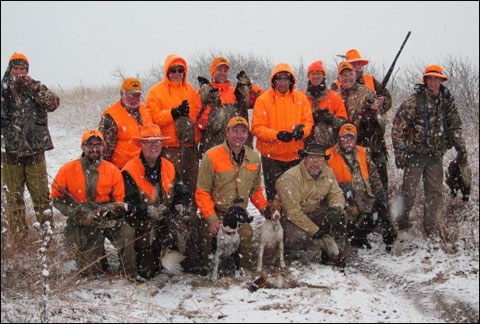
Wing shooting on the farm where I grew up in Montgomery County Illinois, about 25 miles south of Springfield, in the late 1950’s and early 1960’s was pretty much limited to pass shooting doves down by the pond, jump shooting ducks on local farm ponds or hunting quail along the fence rows and Osage orange hedge rows that bordered most farm fields and pastures in those days.
Back then there were very few, if any, pheasants where we lived. Consequently, every year we had to drive a couple of hours “up north” to hunt pheasants in the picked corn fields, grass waterways and fence rows near Gibson City (east of Bloomington) and around Streator, Illinois. Still, we considered ourselves lucky if we got our limit of two birds each. In Virginia, where I live now, hunting pheasants is limited to pen-raised birds on preserves.
My nephew Scott and I have hunted together a few times over the years on the family farm in Illinois near where Scott lives and I grew up. The last time we hunted pheasants together was at a state preserve with a limit of two released, pen-raised hens or cocks in 2005. We have talked for years about doing a multi-day bird hunt together, but were never able to pull it off.
I was pleasantly surprised when I got an email from Scott asking if I would be interested in hunting pheasants with him and his college shooting buddy, Rich Miller, for three days in mid-November, 2011 at Outdoor Obsessions near Downs, Kansas in the North-Central region of the state. Scott had hunted doves and quail with Rich and his dad, Steve, but he had never gone pheasant hunting with them. Rich invited Scott to join them and some of their friends in Kansas this year and, after checking with Rich to see if it was okay, Scott invited me to come along.
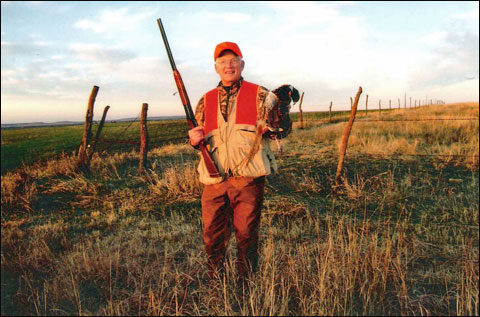 The author with his father’s 16-gauge Marlin Model 90DT manufactured in 1947.
The author with his father’s 16-gauge Marlin Model 90DT manufactured in 1947.Kansas has a state limit of four pheasants per day and allows hunting from sunrise to sunset. It is typically ranked in the top three or four states for the number of wild pheasants killed each season. After checking the Outdoor Obsessions web site to learn more about it, I emailed Scott saying that it sounded like a great opportunity to finally get to hunt together and to count me in.
Scott, who shoots left-handed, is a natural with a shotgun. He grew up in a small town in Illinois not far from the farm where I grew up and where my dad (Scott’s grandfather) now 94, still lives. My dad taught me to wing shoot, and he did the same for Scott. All through high school he and my dad would go skeet shooting several times a month after school or on weekends. Scott enrolled at Arizona State University where he met and became friends with Rich Miller, a member of the Arizona State University Shotgun Team. Scott joined the ASU Shotgun Team, and during his junior year he was the Collegiate All-Around National Champion for his combined scores in five different events (skeet, international skeet, trap, international trap and sporting clays).
My excitement and anticipation of hunting pheasants with my nephew was tempered somewhat when I read the Kansas Department of Wildlife, Parks and Tourism Upland Bird Forecast published in September. The survey indicated that the bird count was way down compared to last year due to poor reproductive conditions from heavy spring rains and hail and poor nesting conditions due to a year-long drought that continued into the summer months in many parts of the state. The KDWPT regional pheasant forecast for North-central Kansas north of I-70 was a little more optimistic, stating that because that area had suffered fewer severe weather events and, with some timely rains, was less affected by the summer drought, the pheasant population should be relatively good.
I was also a little concerned about the hunt after I learned that Scott and I would be joined by 17 other hunters. I had never hunted with such a large group and had no idea how it could possibly work. When early reports after opening day by hunters in the field confirmed that bird counts were down in many parts of the state, I was beginning to wonder if the 1,400-mile trip to Outdoor Obsessions would be worth the effort.
In the weeks before our hunt, Scott and I discussed what guns we should take. I was definitely taking my favorite upland bird gun, a 16-gauge Marlin Model 90DT over/under made in 1947 with 26-inch barrels choked .002 inches (between cylinder and skeet ) and .019 inches (improved modified). A couple of Rich’s friends had suggested setting aside one day of our hunt as “vintage gun day” when everyone would be invited to use a gun at least 50 years old or one older than the hunter.
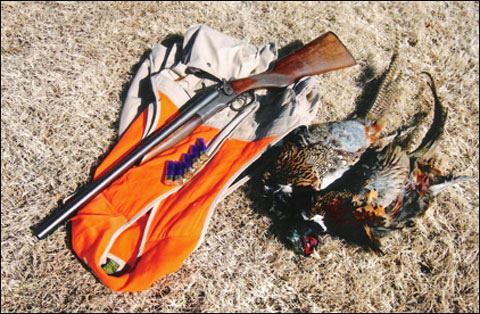 This 16-gauge Springfield-Stevens No. 215 side-by-side hammer gun from the early 1930s belonged to the author’s father. The gun still worked flawlessly, bringing down these pheasants on the Kansas hunt.
This 16-gauge Springfield-Stevens No. 215 side-by-side hammer gun from the early 1930s belonged to the author’s father. The gun still worked flawlessly, bringing down these pheasants on the Kansas hunt.Although my Model 90 met the age requirement, I immediately thought of my Dad’s 16-gauge Springfield-Stevens No. 215 side-by-side hammer gun made in the early 1930s. Dad had bought it new at a local hardware store for $15, and he said it was the only gun he ever got his limit of quail and a pheasant in the same day. Dad sold it to a hunting buddy of his in 1948 or 1949 before I was old enough to shoot it.
About 2½ years ago, I learned that dad’s friend (then in his 80’s) still had that old Stevens side by side, although he had cut off the barrels to 20 inches. I told him if he ever wanted to sell it, that I’d like to buy it. He said if I wanted the gun, I could have it! I offered to pay him for it, but he said, “No, I really want you to have it.”
After getting the gun, I patterned it, and both barrels put 90% in a 30-inch circle at 20 yards. I shot it reasonably well, too, breaking 42×50 wobble clays with most of the shots at 20-35 yards and 43×50 shooting skeet. At that point I thought it could be a decent quail gun. I was less certain how it would work for pheasants, although I thought it might do okay hunting over pointing dogs if the birds were holding. I could think of nothing better than taking Dad’s old side-by-side hammer gun hunting and having the opportunity to bag a pheasant with it.
On Tuesday, November 15, we joined 12 other hunters, including Scott’s friend Rich, and Rich’s father, Steve at Outdoor Obsessions. After a delicious home-cooked dinner, Erik, the owner of Outdoor Obsessions, and a guide, Dale Sprouse, formally welcomed everyone.
He and Dale went over how the hunts would be orchestrated, stressing that, while we were there to have a great time, safety, especially with up to 19 hunters in the field at one time, was paramount. Erik’s rules are simple – gun barrels pointed up at all times and be sure there was plenty of sky between the bird and the ground with no shots to be taken at less than a 45-degree angle above the horizon. He commented that he only had to ask a hunter to leave the field once, but he emphasized that he would not hesitate to do it again if he felt a hunter was acting in an unsafe manner. He then said, “See you all for breakfast at 6:00 am.”
 The Outdoor Obsessions group receives a last-minute hunting and safety briefing before the hunt.
The Outdoor Obsessions group receives a last-minute hunting and safety briefing before the hunt.The next morning, it was overcast and 31 degrees. The forecast called for a 20-percent chance of snow showers, which should end around noon. After a hearty breakfast Erik again explained where we would be hunting first, and illustrated on a white board how we would be setting up. He also took time to go over the safety rules.
By 7:00 am we were almost ready to start our first hunt of the day in a CRP field covered with waist high grass. Erik again went over the safety rules and how we would hunt the field. Four blockers were positioned at one corner of the field with a light wind at their backs, and Scott and I along with six other hunters lined up about 40 yards apart at the other end of the field. As soon as it was shooting time, we started walking into the wind as eight pointing and flushing dogs worked the field ahead of us. Two flankers were positioned on either side of the field, staying about 80-100 yards ahead of us.
 The hunters disburse in the field, taking up positions as blockers, flankers and flushers.
The hunters disburse in the field, taking up positions as blockers, flankers and flushers.At about 100-150 yards from the blockers, the hunters at the end of the line farthest from the corner where the blockers were stationed, and the flanker on that side began to swing around until we formed a semi-circle to push the birds into the corner in front of the blockers. That’s when things really got exciting. Pheasants seemed to be flying everywhere, and the blockers were taking as many or more shots than the rest of us as pheasants ran and flushed ahead of the dogs. The group killed at least 20 pheasants in that first field and probably should have gotten a few more.
Before long it started to spit some light snow. By mid-morning large, fluffy snowflakes were really coming down. That 20-percent chance of snow showers became over two inches on the ground by noon. It was only the second time in the past 30-plus years that I had an opportunity to hunt pheasants in the snow, and there is nothing to compare with it. Hunting in the snow, our group of 14 hunters had killed the limit of 56 birds before lunch time.
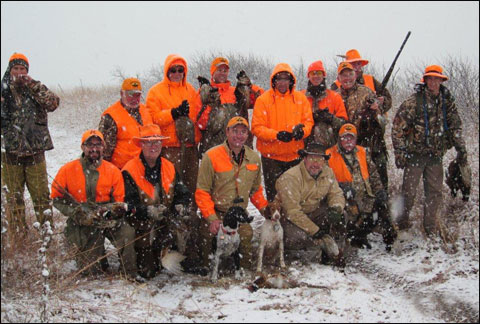 Taking a break from pheasant hunting in the snow at Outdoor Obsessions.
Taking a break from pheasant hunting in the snow at Outdoor Obsessions.That evening, five other hunters arrived, including Rich’s brother-in-law, also named Rich, who was accompanied by his two sons (Rich Miller’s nephews), Mathew, 15, and Patrick, 18. That brought the total to 19 who would be hunting together over the next two days.
When we got to the field before shooting time on Thursday, the sky was clear and the temperature was 14 degrees. A little snow remained on the grass from the previous day’s snowfall. It was also “vintage gun day,” and I had my dad’s old 16-gauge side-by-side hammer gun with a box of purple 1-oz. #6 Federal’s ready to go. Since both barrels are now cylinder choke, I knew I needed to be very selective on my shots, which is sometimes easier said than done in the heat of the moment when cock pheasants are in the air.
I was a blocker on the first hunt that morning, and the very first bird I shot at was a high incoming shot of about 20-25 yards. I let out a loud “Whoop” when it folded up on the first shot and dropped dead on the ground about 15 yards behind me. It was the first pheasant taken with that old side by side in over 60 years, and other than being able to hunt with my nephew was the highlight of the trip for me.
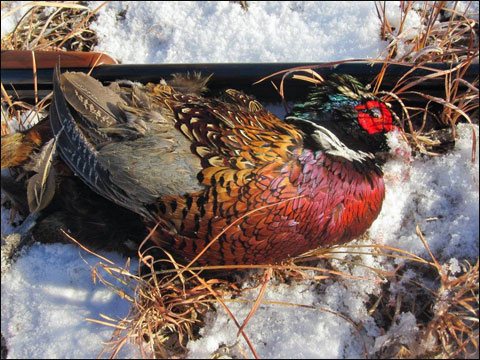 One of the pheasants taken with the author’s 16-gauge Springfield-Stevens.
One of the pheasants taken with the author’s 16-gauge Springfield-Stevens.A few minutes later I shot my second bird as it crossed high left to right. It dropped at 30 paces. I was walking later that morning when, after two or three missed opportunities, I got the third pheasant with it, a quartering left to right shot that also dropped at 30 paces (with the second barrel). One in particular that did get away was an easy straight away shot of 20-25 yards that I missed with both barrels and left me shaking my head in disbelief. After lunch I got my fourth pheasant of the day using my 16-gauge Marlin.
On Thursday and Friday with 19 hunters, most of the CRP fields we hunted were large – at least 40 acres (¼ mile x ¼ mile). Using a similar set up as the day before, 10 walkers would spread out about 40-yards apart, covering almost the full width of the field heading into the wind. A flanker was placed on either side of the field keeping about 80-100 yards ahead of the walkers. The remaining seven were blockers who set up about 60-70 yards apart at a far corner of the field with the wind more or less at their backs.
That day, 19 hunters killed 71 pheasants, and on Friday the same 19 hunters got 70 birds. A couple of them were what our guide Dale called “pillow shots,” birds taken at such close range that all you saw was a big puff of feathers. Unfortunately, those birds were so shot up they had to be discarded.
Back in Virgina, when I mentioned that 19 hunters had killed 197 pheasants in three days, one individual in particular commented that we had to be shooting released, pen-raised birds. I assured him we were not.
Erik Vrbas, the owner of Outdoor Obsessions, leases about 3,800 acres of mostly CRP land. Erik helps supplement the wild bird population by releasing several hundred hens each spring. Every year he also raises day-old cock chicks in “surrogators” in the fields. The birds are released at five weeks of age, and they “imprint’ on that field where they are released. By hunting season they act and fly just like their wild cousins.
Erik told me that while those efforts help, it is the wild-bird brood that he depends on from year to year. One of the keys to sustaining large numbers of wild birds is good habitat. I’ve hunted wild pheasants in Montana, on the Standing Rock Indian Reservation in North Dakota/South Dakota, and on private land near Russell, Kansas, and the CRP land that Erik leases and the food plots he plants provide some of the best habitat for pheasants that I’ve seen.
The pheasants at Outdoor Obsessions flew just as fast (especially with a 25-mph tail wind) just as high and were just as hard to kill as the wild birds in those other areas of the country that I’ve hunted. There is a big difference between “put” pen-raised adult birds and day-old chicks “stocked” at 5 weeks of age, and the pheasants we hunted at Outdoor Obsessions were certainly nothing like the pen-raised birds that I’ve hunted on preserves in Virginia and Illinois.
Overall, the experience exceeded my expectations and was both memorable and interesting on several counts. It was memorable because it was the first time I had the chance to go hunting with my nephew since 2005. I saw a lot more pheasants than I thought I would, given the pessimistic early reports. I was able to kill some pheasants with my dad’s 80-year old Springfield-Stevens, and it was only the second time in the past 30-plus years that I got to hunt pheasants in the snow. Watching the well-trained dogs work was an added treat.
It was interesting because Scott and I hunted with 17 other hunters. It was the first time I had hunted with such a large group and really didn’t know what to expect. I did not need to be concerned, because the way the hunts were orchestrated, it worked extremely well. I also got to meet and enjoy the camaraderie of fellow upland bird hunters from many different parts of the country, sharing our hunting experiences, information about our favorite (and not so favorite) shotguns and more. I also enjoyed watching and hunting with two of the next generation of bird hunters. Both of Rich Miller’s nephews, Matthew (15) and Patrick (18), acquitted themselves very well in the field. They were courteous, safe and good shots, which is a testament to their upbringing and training.
Outdoor Obsessions offers guided pheasant hunts on privately owned property; clean, comfortable lodging that can accommodate 20-22 hunters, open bar and three home-cooked meals per day. Eric also has pointing and flushing dogs available to assist hunters if needed at no extra cost. While Outdoor Obsessions may not be the height of luxury that some might want or expect, at a cost of less than $325/day plus tips (includes bird cleaning) what Erik and Outdoor Obsessions has to offer was, to me, an excellent value and well worth the trip. You can find Outdoor Obsessions on the Internet at http://www.myoutdoorobsessions.com.
Barry L. Marten, who grew up on a farm in central Illinois, now lives in Virginia. Over the past 50 years, he has hunted wild pheasants in Illinois, North Dakota and South Dakota, Montana and the North-Central region of Kansas. While he generally hunts with a 16-gauge Marlin Model 90 over/under, no other gun holds a more personal connection than his father’s 80-year old Springfield-Stevens No. 215 side-by-side hammer gun.


Comments